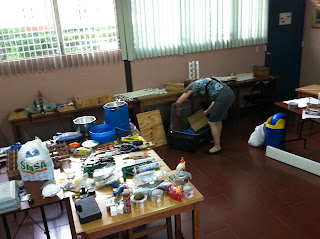Aris Reyes came in to Managua to see my prototype and give me feed back. He is a prosthetics technician in Nicaragua who makes prosthetics for patients and then teaches them how to use them. The first thing he did was say the the coffee may not be flexible enough and that blowing air in might help and we set up the vacuum to blow. My prototype was not designed for that and one of the seams ripped. It was okay though because Aris wanted to use a bucket instead of the bag. We went next door to Sinsa to get plaster, a bucket and a rubber band. We got a garage bucket and gloves which we cut the elastic out of to make a rubber band, but we didn't get any plaster. The fastest plaster they sold dried in 45 min, which Aris said was too long. We then went to the market to pick up some plaster from someone Aris knew.
The guy who we meet turned out to make prosthetics himself in a shop in the market. He had been making prosthetics for 30 years. He started during the civivl war in the 80's when he would have 200 patients a month. The guy said that he makes 2 prosthetics a week, each one costing $500. 70% of that cost he says is materials. Materials include the plastic socket which is the hardest part to make because it need to be heated up to 350 degrees C. He also said that most patients have to come back within the first week because it is uncomfortable.
Some foot braces in the shop
The special fast drying plaster (yesso)
Entering the workshop
Prosthetics maker and some of his work
The deal for the plaster
Plaster positive mold finished
Another view of a positive mold
Exercise equipment in the workshop
Plastic oven in the back room
More of the prosthetic maker's work
The entrance to the workshop/store
-Annie

































